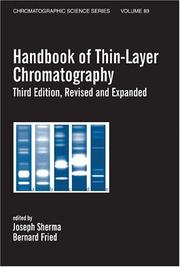| Listing 1 - 10 of 32 | << page >> |
Sort by
|
Book
ISBN: 1493909150 1493909142 1322133077 Year: 2014 Publisher: New York, NY : Springer New York : Imprint: Springer,
Abstract | Keywords | Export | Availability | Bookmark
 Loading...
Loading...Choose an application
- Reference Manager
- EndNote
- RefWorks (Direct export to RefWorks)
Digenetic trematodes constitute a major helminth group that parasitize humans and animals, and are a major cause of morbidity and mortality. The diseases caused by trematodes have been neglected for years, especially as compared with other parasitic diseases. However, the geographical limits and the populations at risk are currently expanding and changing in relation to factors such as growing international markets, improved transportation systems, and demographic changes. This has led to a growing international interest in trematode infections, although factors such as the difficulties entailed in the diagnosis, the complexity of human and agricultural practices, the lack of assessments of the economic costs, or the limited number of effective drugs are preventing the development of control measures of these diseases in humans and livestock. In-depth studies are needed to clarify the current epidemiology of these helminth infections and to identify new and specific targets for both effective diagnosis and treatments. The main goal of this book is to present the major trematodes and their corresponding diseases in the framework of modern parasitology, considering matters such as the application of novel techniques and analysis of data in the context of host-parasite interactions and to show applications of new techniques and concepts for the studies on digenetic trematodes. This is an ideal book for parasitologists, microbiologists, zoologists, immunologists, professional of public health workers, clinicians, and graduate and post-graduate students.
Medical parasitology. --- Parasitic diseases. --- Trematoda. --- Medicine. --- Immunology. --- Medical microbiology. --- Vaccines. --- Parasitology. --- Biomedicine. --- Medical Microbiology. --- Vaccine. --- Biology --- Biologicals --- Immunobiology --- Life sciences --- Serology --- Clinical sciences --- Medical profession --- Human biology --- Medical sciences --- Pathology --- Physicians --- Fluke worms --- Flukes (Platyhelminthes) --- Flukeworms --- Trematode worms --- Trematodes --- Platyhelminthes --- Communicable diseases --- Medical parasitology --- Human beings --- Human parasitology --- Parasitology --- Parasitic diseases --- Parasites --- Microbiology. --- Microbial biology --- Microorganisms

ISBN: 0824783352 Year: 1991 Volume: 55 Publisher: New York Dekker
Abstract | Keywords | Export | Availability | Bookmark
 Loading...
Loading...Choose an application
- Reference Manager
- EndNote
- RefWorks (Direct export to RefWorks)
Book
ISBN: 0824776097 Year: 1986 Publisher: New York, NY : Marcel Dekker,
Abstract | Keywords | Export | Availability | Bookmark
 Loading...
Loading...Choose an application
- Reference Manager
- EndNote
- RefWorks (Direct export to RefWorks)
Book
ISBN: 1441970274 9786612971112 1282971115 1441970282 1489982396 Year: 2011 Publisher: New York : Springer,
Abstract | Keywords | Export | Availability | Bookmark
 Loading...
Loading...Choose an application
- Reference Manager
- EndNote
- RefWorks (Direct export to RefWorks)
This book on “Biomphalaria Snails and Larval Trematodes” presents up to date information on the interactions of these snails and their trematode parasites, particularly on Schistosoma spp. larvae. Snails of the genus Biomphalaria are of significant medical importance since several species in this genus are obligate intermediate hosts of the human blood fluke S. mansoni, the causative agent of hepatosplenic schistosomiasis. In addition to the impact of Biomphalaria spp. on public health, these snails are also interesting models for the study of other topics such as population biology, including genetics and demography, proteomics, invertebrate immunobiology, mating systems, biogeography, among others. A purpose of this book is to provide an overview of the recent advances in Biomphalaria spp.-larval trematode interactions, especially in Biomphalaria-schistosome systems. Emphasis is placed on gaps in our knowledge that need to be filled to gain a better understanding of the relationships in these host-parasite systems. This may be critical to obtain a better understanding of our knowledge of the transmission of schistosomiasis and other snail-borne parasitic diseases. The book, “Biomphalaria Snails and Larval Trematodes” is an ideal volume for researchers and advanced students interested in modern aspects of parasitology , malacology and public health.
Biomphalaria. --- Snails. --- Trematoda. --- Biomphalaria --- Trematoda --- Host-parasite relationships --- Schistosomiasis --- Snails as carriers of disease --- Trematode Infections --- Snails --- Platyhelminths --- Host-Pathogen Interactions --- Biology --- Host-Parasite Interactions --- Parasitology --- Helminths --- Biological Processes --- Gastropoda --- Helminthiasis --- Biological Science Disciplines --- Parasitic Diseases --- Mollusca --- Natural Science Disciplines --- Invertebrates --- Biological Phenomena --- Phenomena and Processes --- Diseases --- Disciplines and Occupations --- Animals --- Eukaryota --- Organisms --- Zoology --- Invertebrates & Protozoa --- Microbiology & Immunology --- Health & Biological Sciences --- Parasites --- Larvae --- Host-parasite relationships. --- Schistosomiasis. --- Parasites. --- Larvae. --- Bilharziasis --- Bilharziosis --- Katayama disease --- Snail fever --- Host-organism relationships --- Host-pathogen relationships --- Parasite-host relationships --- Pathogen-host relationships --- Relationships, Host-parasite --- Fluke worms --- Flukes (Platyhelminthes) --- Flukeworms --- Trematode worms --- Trematodes --- Medicine. --- Parasitology. --- Infectious diseases. --- Biomedicine. --- Infectious Diseases. --- Biomedicine general. --- Distomatosis --- Parasitism --- Platyhelminthes --- Planorbidae --- Medical parasitology. --- Emerging infectious diseases. --- Clinical sciences --- Medical profession --- Human biology --- Life sciences --- Medical sciences --- Pathology --- Physicians --- Emerging infections --- New infectious diseases --- Re-emerging infectious diseases --- Reemerging infectious diseases --- Communicable diseases --- Human beings --- Human parasitology --- Parasitic diseases --- Biomedicine, general. --- Health Workforce
Book
ISBN: 3030186156 3030186164 Year: 2019 Publisher: Cham : Springer International Publishing : Imprint: Springer,
Abstract | Keywords | Export | Availability | Bookmark
 Loading...
Loading...Choose an application
- Reference Manager
- EndNote
- RefWorks (Direct export to RefWorks)
Digenetic trematodes constitute a major helminth group that parasitize human and animals and are a major cause of morbidity and mortality. The diseases caused by trematodes have been neglected for years, especially as compared with other parasitic diseases. However, the geographical limits and the populations at risk are currently expanding and changing in relation to factors such as growing international markets, improved transportation systems, and demographic changes. This has led to a growing international interest to the trematode infections, although factors such as the difficulties entailed in the diagnosis, the complexity of human and agricultural practices, the lack of assessments of the economic costs, or the limited number of effective drugs are preventing the development of control measures of these diseases in humans and livestock. In-depth studies are needed to clarify the current epidemiology of these helminth infections and to identify new and specific targets for both effective diagnosis and treatments. The main goal of the second edition of this book is to present the major trematodes and their corresponding diseases in the framework of modern parasitology, considering matters such as the application of novel techniques and analysis of data in the context of host-parasite interactions and to show applications of new techniques and concepts for the studies on digenetic trematodes. This is an ideal book for parasitologists, microbiologists, zoologists, immunologists, professional of public health workers, clinicians and graduate and post-graduate students. .
Trematoda. --- Medical parasitology. --- Immunology. --- Food --- Vaccines. --- Parasitology. --- Food Microbiology. --- Vaccine. --- Microbiology. --- Biologicals --- Foods --- Dinners and dining --- Home economics --- Table --- Cooking --- Diet --- Dietaries --- Gastronomy --- Nutrition --- Immunobiology --- Life sciences --- Serology --- Human beings --- Human parasitology --- Medical sciences --- Parasitology --- Parasitic diseases --- Parasites --- Sanitary microbiology --- Bacteriology --- Microbiology. --- Microbial biology --- Biology --- Microorganisms

ISBN: 1135567360 0429222351 1135567379 058513510X 9786610178971 1280178973 0203910214 9780585135106 0824742087 9780824742089 9780824702229 0824702220 0824702220 9781135567361 9780203910214 9781135567378 9781135567323 Year: 1999 Publisher: New York Marcel Dekker
Abstract | Keywords | Export | Availability | Bookmark
 Loading...
Loading...Choose an application
- Reference Manager
- EndNote
- RefWorks (Direct export to RefWorks)
The fourth edition of this work emphasizes the general practices and instrumentation involving TLC and HPTLC, as well as their applications based on compound types, while providing an understanding of the underlying theory necessary for optimizing these techniques. The book details up-to-date qualitative and quantitative densitometric experiments on organic dyes, lipids, antibiotics, pharmaceuticals, organic acids, insecticides, and more.

ISBN: 0824708954 Year: 2003 Publisher: New York (N.Y.) Dekker
Abstract | Keywords | Export | Availability | Bookmark
 Loading...
Loading...Choose an application
- Reference Manager
- EndNote
- RefWorks (Direct export to RefWorks)
Digital
ISBN: 9780387095776 Year: 2009 Publisher: New York, NY Springer-Verlag New York
Abstract | Keywords | Export | Availability | Bookmark
 Loading...
Loading...Choose an application
- Reference Manager
- EndNote
- RefWorks (Direct export to RefWorks)
Systematics. Taxonomy. Nomenclature --- Genetics --- General parasitology --- General biochemistry --- Immunology. Immunopathology --- Infectious diseases. Communicable diseases --- immunologie --- systematische plantkunde --- biogeografie --- proteomics --- biochemie --- parasitologie --- besmettelijke ziekten --- moleculaire biologie --- proteïnen
Digital
ISBN: 9781441970282 Year: 2011 Publisher: New York, NY Springer New York
Abstract | Keywords | Export | Availability | Bookmark
 Loading...
Loading...Choose an application
- Reference Manager
- EndNote
- RefWorks (Direct export to RefWorks)
General parasitology --- Human biochemistry --- Infectious diseases. Communicable diseases --- medische biochemie --- biochemie --- parasitologie --- besmettelijke ziekten
Digital
ISBN: 9781493909155 Year: 2014 Publisher: New York, NY Springer
Abstract | Keywords | Export | Availability | Bookmark
 Loading...
Loading...Choose an application
- Reference Manager
- EndNote
- RefWorks (Direct export to RefWorks)
Digenetic trematodes constitute a major helminth group that parasitize humans and animals, and are a major cause of morbidity and mortality. The diseases caused by trematodes have been neglected for years, especially as compared with other parasitic diseases. However, the geographical limits and the populations at risk are currently expanding and changing in relation to factors such as growing international markets, improved transportation systems, and demographic changes. This has led to a growing international interest in trematode infections, although factors such as the difficulties entailed in the diagnosis, the complexity of human and agricultural practices, the lack of assessments of the economic costs, or the limited number of effective drugs are preventing the development of control measures of these diseases in humans and livestock. In-depth studies are needed to clarify the current epidemiology of these helminth infections and to identify new and specific targets for both effective diagnosis and treatments. The main goal of this book is to present the major trematodes and their corresponding diseases in the framework of modern parasitology, considering matters such as the application of novel techniques and analysis of data in the context of host-parasite interactions and to show applications of new techniques and concepts for the studies on digenetic trematodes. This is an ideal book for parasitologists, microbiologists, zoologists, immunologists, professional of public health workers, clinicians, and graduate and post-graduate students.
General parasitology --- General microbiology --- Immunology. Immunopathology --- Medical microbiology, virology, parasitology --- Pathological biochemistry --- Human medicine --- immunologie --- vaccins --- medische microbiologie --- medische biochemie --- biochemie --- biomedische wetenschappen --- microbiologie --- parasitologie --- vaccinatie
| Listing 1 - 10 of 32 | << page >> |
Sort by
|

 Search
Search Feedback
Feedback About UniCat
About UniCat  Help
Help News
News